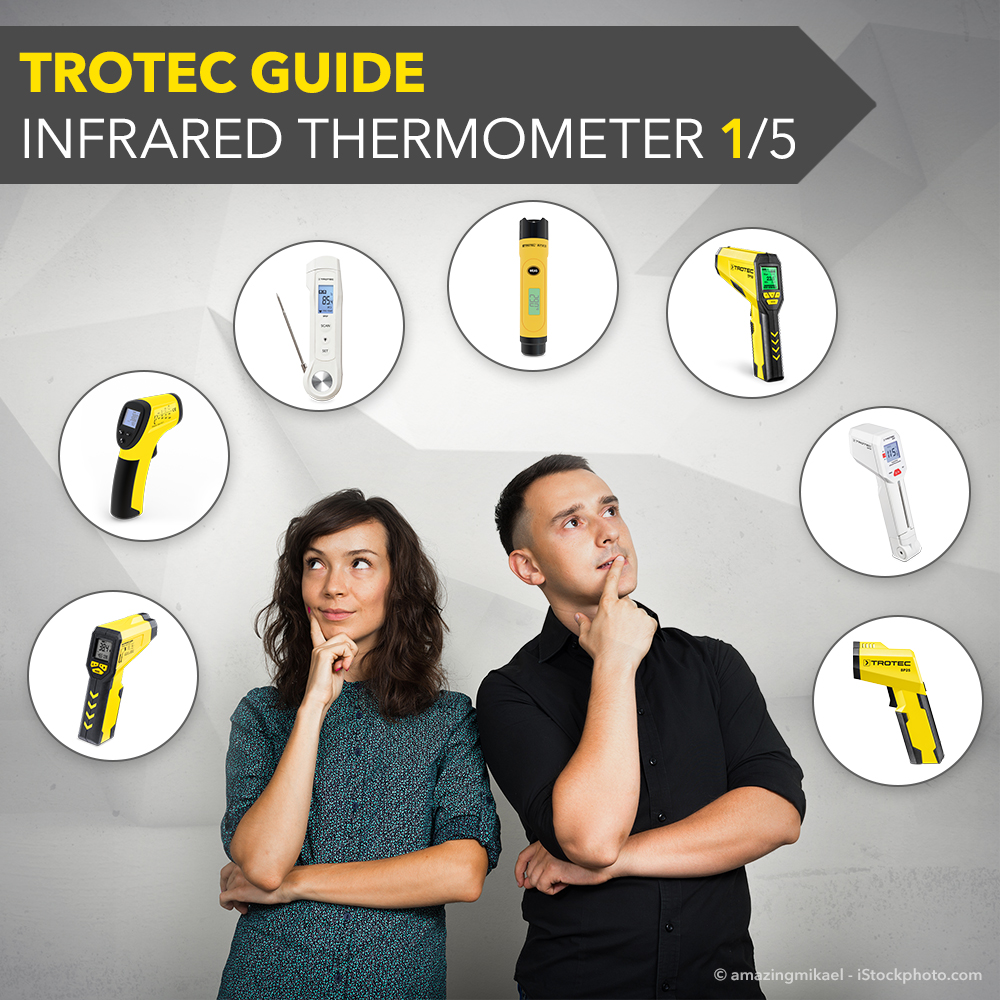 Similar to penetration thermometers, infrared thermometers are digital measuring devices. But because infrared thermometers allow contact-free and hence hygienic and safe measurement at the same time, they are enjoying ever greater popularity. As a result, many users are asking what and how they can actually use their pyrometer for measurement. You can find the answers here – and in four more editions of our new Trotec Beginner’s Guide covering all aspects of the infrared thermometer.
Similar to penetration thermometers, infrared thermometers are digital measuring devices. But because infrared thermometers allow contact-free and hence hygienic and safe measurement at the same time, they are enjoying ever greater popularity. As a result, many users are asking what and how they can actually use their pyrometer for measurement. You can find the answers here – and in four more editions of our new Trotec Beginner’s Guide covering all aspects of the infrared thermometer.
We use a laser pointer to target the measuring object, measure its surface temperature and read this directly off the measuring device: Infrared thermometers are not only very easy to use, they are also extremely versatile and – like the Trotec brand devices – offer a very good range of functions at an affordable price. But before you can make a precise temperature measurement, you need to choose the right thermometer.
Choosing the right infrared thermometer
A standard infrared thermometer such as the BP15 from Trotec is more than adequate for many applications such as workshops, hobbies and handicraft. More complex tasks in industry and trade – for instance reliable diagnosis and maintenance of heating, air-conditioning and ventilation systems – calls for a professional pyrometer like the TP10 with a wide variety of sophisticated measuring functions. The device allows temperature measurements from -50 °C to around +1850 °C plus data exchange with a computer.
Different again is the requirement profile for a thermometer to be used in the area of food inspection. This requires both the surface and core temperature to be measured, keyword HACCP standard. Infrared and penetration thermometers in a combination unit such as the BP2F or BP5F from Trotec are ideal here. But no matter what the individual requirements – Trotec has the right measuring devices for rapid and precise temperature monitoring.
Infrared thermometers with the appropriate emissivity
The emissivity describes the ability of a material to emit infrared energy, which can then be measured by an infrared thermometer. To measure the surface temperature of an object as precisely as possible, information about the material and properties of its surface is useful. The emissivity is determined in a value between 0 and 1. Although low emission values below 0.1 occur predominantly in highly reflective materials such as polished metals, materials with rough surfaces (concrete, wood or painted surfaces and such like) have a high emissivity of 0.7 to 0.98.
The attractively priced basic infrared thermometers from Trotec like the BP05, BP15, BP25 and BP5F have a fixed emissivity of 0.95, this covering a wide range of materials used in trade and craft. Our professional pyrometers also offer individual setting options for optimal measuring results.
Ensuring the correct measuring distance
Most infrared thermometers have a laser pointer, which can be aimed at the measuring object. However, it is not the small marking point that is measured but instead the spot around this point – referred to as the so-called measuring spot. The further you are from the measuring object, the larger the measuring spot via which the temperature is captured – and hence less accurate the measuring result! You should therefore be correspondingly close to the measuring object for precise temperature measurement in order to keep the measuring spot small. By the way, the technical data of almost all infrared thermometers provides information on the measuring optics as a ratio between the measuring distance and size of the measuring spot. Thus a value of 8:1 indicates that the measuring spot is about 1 cm large at a distance of 8 cm.
Trotec pyrometers for professional applications have a resolution of 40:1 (TP7) or 75:1 (TP10) so as to capture the smallest electronic components for instance. These two devices also comes with a multipoint laser targeting aid for displaying the measuring point and measuring spot simultaneously: While a central target laser shows the measuring point, additional lasers visualise the boundary points of the measuring area. In this way, they can easily prevent areas outside the measuring object from being captured, which would falsify the temperature measurement.
More information on infrared thermometers from Trotec
You can find an overview of the contact and infrared thermometers for a wide range of applications in our Trotec Shop. The overview page there is followed by information on our individual brand quality devices – each as precise as it is affordable.
Your overview of Trotec’s ‘infrared thermometers’
1/5 What you need to know for a precise temperature measurement
2/5 How to measure the temperature of foods
3/5 How to measure the temperature of liquids
4/5 How to measure the temperature in a terrarium
5/5 The ‘Mini Format’ – small, handy, quick

